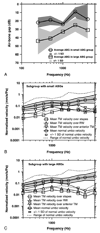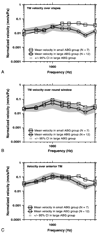Investigation of the mechanics of Type III stapes columella tympanoplasty using laser-Doppler vibrometry
- PMID: 17948356
- PMCID: PMC2586981
- DOI: 10.1097/mao.0b013e31811f40fb
Investigation of the mechanics of Type III stapes columella tympanoplasty using laser-Doppler vibrometry
Abstract
Objectives: To investigate the middle ear mechanics of Type III stapes columella tympanoplasty using laser-Doppler vibrometry (LDV) and to determine whether LDV was useful in the identification of structural factors responsible for poor hearing outcomes.
Background: The Type III stapes columella tympanoplasty procedure involves placing a tympanic membrane (TM) graft directly onto the stapes head. Postoperative hearing results vary widely, with air-bone gaps (ABGs) ranging from 10 to 60 dB.
Methods: Laser-Doppler vibrometry measurements were performed in 22 patients (23 ears) who underwent Type III stapes columella tympanoplasty. The measurements were made at three locations on the TM graft: over the stapes head, over the round window, and on the anterior TM. The LDV results were correlated with the clinical and audiologic findings.
Results: The 23 ears were divided into three groups: Nonaerated ears (n = 2). The ABGs were 30 to 60 dB. The TM velocities over all three locations were 20 to 40 dB lower than normal umbo velocity (in normally hearing subjects). Fixed stapes with aerated middle ear (n = 2). The ABGs were 40 to 60 dB, and TM velocities were equivalent to normal umbo velocity in one case and lower by 15 to 20 dB in another case. Mobile stapes and aerated middle ear (n = 19). There were two subgroups in this category: 1) small ABGs less than 25 dB (n = 7) and large gaps greater than or equal to 25 dB (n = 12). There were small differences in TM graft velocity at all three measurement locations between these two subgroups. However, these small differences did not explain the large difference in ABG between the two subgroups.
Conclusion: Nonaeration of the middle ear and stapes fixation lead to large residual conductive hearing losses after Type III tympanoplasty. Laser-Doppler vibrometry can aid in the diagnosis of nonaeration of the middle ear but does not readily diagnose stapes fixation. Postoperative results can vary even in cases of a mobile stapes and an aerated middle ear. We hypothesize that these variations may be the result of differences in the coupling between the TM graft and the stapes head. Measurements of TM velocities by means of LDV did not show clear differences between cases with good hearing and cases with poor hearing in ears with a mobile stapes and an aerated ear. Except for diagnosis of nonaeration of the middle ear, LDV seems to have limited clinical usefulness to identify causes of failure after Type III tympanoplasty.
Figures





Similar articles
-
Middle ear mechanics of Type III tympanoplasty (stapes columella): II. Clinical studies.Otol Neurotol. 2003 Mar;24(2):186-94. doi: 10.1097/00129492-200303000-00010. Otol Neurotol. 2003. PMID: 12621330
-
Middle-ear mechanics of Type III tympanoplasty (stapes columella): I. Experimental studies.Otol Neurotol. 2003 Mar;24(2):176-85. doi: 10.1097/00129492-200303000-00009. Otol Neurotol. 2003. PMID: 12621329
-
Diagnostic utility of laser-Doppler vibrometry in conductive hearing loss with normal tympanic membrane.Otol Neurotol. 2003 Mar;24(2):165-75. doi: 10.1097/00129492-200303000-00008. Otol Neurotol. 2003. PMID: 12621328 Free PMC article.
-
Human middle-ear muscle pulls change tympanic-membrane shape and low-frequency middle-ear transmission magnitudes and delays.Hear Res. 2023 Mar 15;430:108721. doi: 10.1016/j.heares.2023.108721. Epub 2023 Feb 11. Hear Res. 2023. PMID: 36821982 Review.
-
Effect of freezing and embalming of human cadaveric whole head specimens on bone conduction.Hear Res. 2023 Mar 1;429:108700. doi: 10.1016/j.heares.2023.108700. Epub 2023 Jan 13. Hear Res. 2023. PMID: 36680872 Review.
Cited by
-
Combined high-speed holographic shape and full-field displacement measurements of tympanic membrane.J Biomed Opt. 2018 Sep;24(3):1-12. doi: 10.1117/1.JBO.24.3.031008. J Biomed Opt. 2018. PMID: 30255670 Free PMC article.
-
Handheld laser-fiber vibrometry probe for assessing auditory ossicles displacement.J Biomed Opt. 2021 Jul;26(7):077001. doi: 10.1117/1.JBO.26.7.077001. J Biomed Opt. 2021. PMID: 34291616 Free PMC article.
-
Novel Applications of Laser Doppler Vibration Measurements to Medical Imaging.Sens Imaging. 2013;14(1):13-28. doi: 10.1007/s11220-013-0077-1. Epub 2013 Aug 13. Sens Imaging. 2013. PMID: 24764800 Free PMC article.
-
Exclusive Two Handed Endoscopic Cartilage Type 3 Tympanoplasty with Endoscope Holders.Indian J Otolaryngol Head Neck Surg. 2022 Aug;74(Suppl 1):686-691. doi: 10.1007/s12070-021-02484-1. Epub 2021 Mar 9. Indian J Otolaryngol Head Neck Surg. 2022. PMID: 36032902 Free PMC article.
-
Controlled exploration of the effects of conductive hearing loss on wideband acoustic immittance in human cadaveric preparations.Hear Res. 2016 Nov;341:19-30. doi: 10.1016/j.heares.2016.07.018. Epub 2016 Aug 3. Hear Res. 2016. PMID: 27496538 Free PMC article.
References
-
- Zollner F. The principles of plastic surgery of the sound-conducting apparatus. J Laryngol Otol. 1955;69:637–652. - PubMed
-
- Wullstein H. The restoration of the function of the middle ear, in chronic otitis media. Ann Otol Rhinol Laryngol. 1956;65:1020–1041. - PubMed
-
- Nadol JB, McKenna MJ. Surgery of the Ear and Temporal Bone. 2nd ed. New York, NY: Raven Press; 2005.
-
- Glasscock ME, Gulya AJ. Surgery of the Ear. 5th ed. Philadelphia, PA: W.B. Saunders Co; 2002.
-
- Juers AL. Myringostapediopexy. Arch Otolaryngol. 1960;71:376–379. - PubMed
Publication types
MeSH terms
Grants and funding
LinkOut - more resources
Full Text Sources
Miscellaneous

